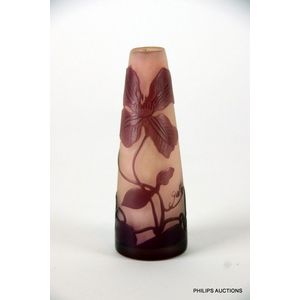Art Nouveau Galle Cameo Vase
You must be a subscriber, and be logged in to view price and dealer details.
Subscribe Now to view actual auction price for this item
When you subscribe, you have the option of setting the currency in which to display prices to $Au, $US, $NZ or Stg.
- Pontil Mark - A pontil mark, also known as a pontil scar, is a distinctive mark or scar found on the base of certain types of glass. It is a remnant of the glassblowing process and is particularly associated with handcrafted items made prior to the widespread use of automated manufacturing.
The pontil mark is created during the final stages of production. After the glassblower has shaped and formed the glass object, it is removed from the blowing iron. At this point, the glass object is often attached to a solid rod called a pontil rod or punty for further shaping, finishing, or attaching additional components. The attachment point is typically at the base of the object.
Once the glass item is complete, it is detached from the pontil rod, leaving behind a mark or scar on the base. This mark can take various forms, such as a rough or irregular surface, a concave or slightly recessed area, or a small circular scar. The presence of a pontil mark indicates that the item was handcrafted rather than mass-produced.
Collectors and historians often use pontil marks as clues to determine the age, authenticity, and production methods of glass or ceramic pieces. Different types of pontil marks may suggest different techniques used in the production process. For example, an open pontil mark is one where the scar is left as an exposed, roughened area, while a closed pontil mark occurs when the scar is smoothed or covered in some way. It's important to note that not all handcrafted glass items have pontil marks, as some artisans developed alternative methods for finishing their work. In Edwardian times the pontil mark was oftern ground off leaving a concave circle in the centre of the base of the object.
The use of pontil marks diminished with the advent of industrialization and automated manufacturing processes in the 19th and 20th centuries. - Circa - A Latin term meaning 'about', often used in the antique trade to give an approximate date for the piece, usually considered to be five years on either side of the circa year. Thus, circa 1900 means the piece was made about 1900, probably between 1895 and 1905. The expression is sometimes abbreviated to c.1900.
- Art Nouveau Period - The Art Nouveau period was a cultural movement that emerged in the late 19th century, and was characterized by its emphasis on natural forms, flowing lines, and a decorative, ornamental style. Art Nouveau was a reaction against the ornate and heavily stylized designs of the previous era, and sought to create a new, more organic aesthetic.
Art Nouveau was characterized by its use of sinuous, curving lines, as well as a focus on natural elements such as flowers, vines, and other organic shapes. Art Nouveau designers sought to create a total work of art, in which every element of a building or object was designed to be harmonious with the overall design.
Some of the most iconic examples of Art Nouveau design include the Paris Metro entrances designed by Hector Guimard, the works of the artist Alphonse Mucha, and the architecture of Victor Horta in Brussels.
The Art Nouveau period was at its peak between 1890 and 1910, but began to decline in popularity by the start of World War I. However, Art Nouveau remains an important influence on design and art to this day, and continues to be celebrated for its emphasis on natural forms and decorative style.
This item has been included into following indexes:
Visually similar items

Chanel, sunglasses, acetate frame with chain and leather arm details, square brown lens, stamped 'CHANEL, Made in Italy', with pouch, leather hard case and Chanel box, width 14 cm

Alvar Aalto (Finnish, 1898-1976), seven bar stools, model 64, designed 1935, lacquered birch, retain manufacturer and retailer's decal labels (7), height 65 cm. Provenance: Anibou, Sydney

Gold and gem set bangle, 14ct yellow gold, cabochon coral and lapis set band terminating with two mythical beast heads set with sapphires, diamonds, emerald eyes and multi-band ruby collar, stamped '14K', with safety clasp. Weight 72 grams

Pair Wedgwood breakfast mugs commemorative Coronations 1937, 1953 designed by Eric Ravilious (1937 crazed staining to interior)
